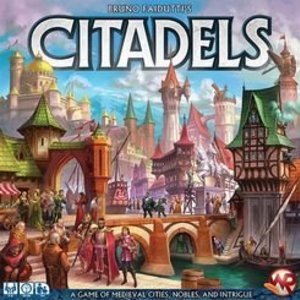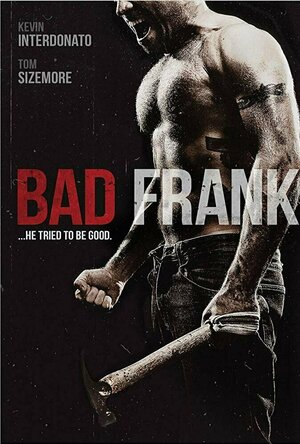Search
Purple Phoenix Games (2266 KP) rated Hierarchy in Tabletop Games
Oct 1, 2019
It’s the moment you’ve all been waiting for – the next installment in the Button Shy wallet series is here! *Crowd roar* After my discovery of Button Shy through their Kickstarter for Sprawlopolis, I have actively been on the lookout for their games. When I saw the call for reviewers for their newest card game, I knew I wanted to be involved! So how does Hierarchy hold up compared to their other wildly successful wallet games? Keep reading to find out!
Hierarchy is an abstract strategy game of perfect information for 2 players. Comprised of a mere 14 playing cards (excluding title and reference cards) it is quite the compact game – as is to be expected from the Button Shy crew. In a game of Hierarchy, players take turns playing cards from their open hand (no hidden information here!) on top of the last card played by their opponent, per the placement restrictions. To win, you must be able to play a card on top of which your opponent is unable to play a card – effectively ‘checkmating’ them and claiming victory for yourself!
DISCLAIMER: We were provided a prototype copy of this game for the purposes of this review. As this is a preview copy of the game, I do not know if the final rules or components will be similar or different to what we were provided. -T
Here’s how it works in detail. Each player first receives a Quick Reference Card, and is then dealt half of the deck (7 cards). The cards are double-sided to represent the two player colors – purple and gold – so each player flips their 7 cards to show their chosen color. Since this is a game of perfect information, all cards are laid out on the table, so each player always knows what cards their opponent has available to them. The player who was dealt the ‘Imposter’ card goes first. Each card has a specific number, ranging from 1 to 13, as well as a specific ability. To play a card, its number must be higher than that of the card below it, unless the card’s specific ability says it can be played otherwise. For example, if I play the Queen (#12), Travis could play the King (#13, numerically higher) or the Assassin (#1) since its power allows it to be played atop any card except for the Tower and Leper. Don’t be worried about having to memorize all the card abilities – they are all detailed on the Quick Reference Cards (see photo below). Play continues back and forth until one player is unable to play a card, either because they have no cards left at all or because they have no valid cards left to play. That player loses the game, and the remaining player is the top of the Hierarchy! (Roll credits)
Let’s talk components first. They’re excellent, which is no surprise coming from ButtonShy. Of course, we just have a preview copy of the game, so I can only imagine that the card quality might be up for improvement during the Kickstarter. That being said, the cards we received are nice and sturdy, as is the tell-tale wallet of a ButtonShy game. The text on the cards is a good size, and the font is easy to read. The artwork is fine, but quite honestly not something I looked at in depth until Travis mentioned the style. I think that’s because the cards are all monochrome, the art just didn’t really draw my eye. Not a knock on the game, just something I noticed! Speaking of color, I personally love the player color choices of Purple and Gold – the school colors of my Alma Mater ((the University of Northern Iowa, go Panthers!)(also of the Alma Mater of the rest of us – Western Illinois University – GO NECKS! -T)). Maybe I’m biased, but I think those two colors are a great combination 🙂
And how about the gameplay? I think it’s excellent. For such a compact and ‘light’ game, the strategy required for success keeps the game extremely engaging. You always know the cards your opponent has, and you’ve got to be thinking at least several turns in advance to try to back them into a corner while not letting yourself fall victim to an unnoticed strategic play. Another neat thing about Hierarchy is how quickly it plays – typically in 20 minutes or less. You might have to devote a decent amount of brainpower to outwitting your opponent, but you definitely don’t need to devote hours of time during your game night for this game, and I love that. Gamers who enjoy games like Citadels or Love Letter might enjoy the familiarity of Hierarchy’s gameplay coupled with the intimacy of a strictly 2-player game. The final verdict from me is that Button Shy has another hit on their hands with Hierarchy. I am very much looking forward to following the campaign, and definitely plan to pull this game out many times in my future!
Hierarchy is an abstract strategy game of perfect information for 2 players. Comprised of a mere 14 playing cards (excluding title and reference cards) it is quite the compact game – as is to be expected from the Button Shy crew. In a game of Hierarchy, players take turns playing cards from their open hand (no hidden information here!) on top of the last card played by their opponent, per the placement restrictions. To win, you must be able to play a card on top of which your opponent is unable to play a card – effectively ‘checkmating’ them and claiming victory for yourself!
DISCLAIMER: We were provided a prototype copy of this game for the purposes of this review. As this is a preview copy of the game, I do not know if the final rules or components will be similar or different to what we were provided. -T
Here’s how it works in detail. Each player first receives a Quick Reference Card, and is then dealt half of the deck (7 cards). The cards are double-sided to represent the two player colors – purple and gold – so each player flips their 7 cards to show their chosen color. Since this is a game of perfect information, all cards are laid out on the table, so each player always knows what cards their opponent has available to them. The player who was dealt the ‘Imposter’ card goes first. Each card has a specific number, ranging from 1 to 13, as well as a specific ability. To play a card, its number must be higher than that of the card below it, unless the card’s specific ability says it can be played otherwise. For example, if I play the Queen (#12), Travis could play the King (#13, numerically higher) or the Assassin (#1) since its power allows it to be played atop any card except for the Tower and Leper. Don’t be worried about having to memorize all the card abilities – they are all detailed on the Quick Reference Cards (see photo below). Play continues back and forth until one player is unable to play a card, either because they have no cards left at all or because they have no valid cards left to play. That player loses the game, and the remaining player is the top of the Hierarchy! (Roll credits)
Let’s talk components first. They’re excellent, which is no surprise coming from ButtonShy. Of course, we just have a preview copy of the game, so I can only imagine that the card quality might be up for improvement during the Kickstarter. That being said, the cards we received are nice and sturdy, as is the tell-tale wallet of a ButtonShy game. The text on the cards is a good size, and the font is easy to read. The artwork is fine, but quite honestly not something I looked at in depth until Travis mentioned the style. I think that’s because the cards are all monochrome, the art just didn’t really draw my eye. Not a knock on the game, just something I noticed! Speaking of color, I personally love the player color choices of Purple and Gold – the school colors of my Alma Mater ((the University of Northern Iowa, go Panthers!)(also of the Alma Mater of the rest of us – Western Illinois University – GO NECKS! -T)). Maybe I’m biased, but I think those two colors are a great combination 🙂
And how about the gameplay? I think it’s excellent. For such a compact and ‘light’ game, the strategy required for success keeps the game extremely engaging. You always know the cards your opponent has, and you’ve got to be thinking at least several turns in advance to try to back them into a corner while not letting yourself fall victim to an unnoticed strategic play. Another neat thing about Hierarchy is how quickly it plays – typically in 20 minutes or less. You might have to devote a decent amount of brainpower to outwitting your opponent, but you definitely don’t need to devote hours of time during your game night for this game, and I love that. Gamers who enjoy games like Citadels or Love Letter might enjoy the familiarity of Hierarchy’s gameplay coupled with the intimacy of a strictly 2-player game. The final verdict from me is that Button Shy has another hit on their hands with Hierarchy. I am very much looking forward to following the campaign, and definitely plan to pull this game out many times in my future!
Purple Phoenix Games (2266 KP) rated Citadels in Tabletop Games
Aug 13, 2021
It has been documented several times that I, Travis Lopez, would be a horrible city planner. So why do I keep playing these games that require me to build city buildings and components and why do I enjoy them so much? Well, truth be told, this is a game that I had traded for years ago, got rid of, missed terribly, and repurchased. However, this is the newer version that includes a lot more in the box. Does it mean that the game is better? More stuff means better game, right?
In Citadels players will be donning the mantle of potential Master Builders and will need to build the greatest buildings within the city and manipulate the powers of special people within its walls. The game ends when a player has built their seventh district building. The player with the most VP at this time will be crowned Master Builder and winner of Citadels!
To setup, decide which eight characters will be used in the game, gather their cards and tokens, and place their tokens in ascending order on the table. This is to remind all players which characters (and their rank) is in play. Assemble the district (building) cards per the rules and shuffle the deck. Deal each player four of these district cards along with two gold coins. The eldest player will begin the game as the current First Player (complete with crown mini) and will begin the first phase of the first round.
Citadels is played over several rounds, each with two phases played within. The first phase is the Selection Phase, where the current First Player takes the character cards, shuffles them, adds zero to two cards (dependent upon number of players) face-up on the table and one card face-down. They then choose from the cards remaining in hand which character’s powers they would like to enact for the turn. The cards are passed to the next player in line who will do the same, and so on around the table.
Once all players have chosen their character card, the Turn Phase can begin. The current First Player (the one with the crown) will announce the characters in rank order, with the lowest character going first. In a typical game using only original base characters, this is “1: Assassin.” Whomever chose the Assassin card will flip over their character card, perform its special power, and then continue with their turn. In this case, the Assassin’s special power is to announce the name of a CHARACTER to assassinate. NOTE: This does NOT mean the name of the PLAYER. So the Assassin could choose to assassinate the King character, not the Travis player. After the character has used their power, the player can continue with the rest of their turn, though some character powers may be used at any time during the player’s turn.
After the character power is used, the player will gather resources in the form of two gold coins from the bank or by drawing two district cards from the deck and choosing one to keep in hand. After this choice, the player may then build one district in their play area if they wish and if they can afford to do so. Once complete, the crowned First Player will call out the next character rank (2: Thief in our example) who will continue their turn in the same way. The game continues in this fashion until a player has built their seventh district. The round continues until all players have had an equal amount of turns. Players then count VP on district cards and bonuses per the rulebook. The player with the most VP at the end of the game is crowned the Master Builder and winner of Citadels!
Components. I have to say that I enjoyed the components in the older version of Citadels I used to have just fine. I had sleeved all my cards, and the gold coins were nice back in the day. This version, however, includes many more components and each one is higher quality than the previous version’s. The art on the cards has been updated and is much much nicer now as well. The addition of the crown mini, the character tokens, and other components not mentioned here merely increases my love for Citadels. Windrider has knocked it out of the park with this version. And that’s saying nothing about all the additional characters now included in the game! Oh boy, so much variability!
Along with that variability is the customization of the game. You can play with one of the six pre-constructed provided suggestions in the rulebook or create your own combination of different characters. With three versions of each rank, many possibilities are… possible.
I do love Citadels, and with the right group can be a show-stopper all on its own. Some players may get a little offended or sassy because there is a fair amount of Take That in Citadels with the character interactions, so if playing with people who don’t understand the difference between a game and real life, I would prep them appropriately. I love being able to outwit my opponents by drafting certain characters they didn’t think I would want. Keeping them all on their toes during the game is sneaky fun.
So for me, with the amount of replayability, high quality and excellent components, and cutthroat gameplay I simply adore Citadels. I can pull it out with different groups and have different play experiences and try to tailor the character offering to the strengths of my players, or simply use one listed in the back of the rulebook. Purple Phoenix Games gives Citadels an underhanded, yet scholarly 21 / 24. It’s a stunning, magical, wonderful game and one of Bruno Faidutti’s best ever! Surely this is already in your collection, right? If not, make it so.
In Citadels players will be donning the mantle of potential Master Builders and will need to build the greatest buildings within the city and manipulate the powers of special people within its walls. The game ends when a player has built their seventh district building. The player with the most VP at this time will be crowned Master Builder and winner of Citadels!
To setup, decide which eight characters will be used in the game, gather their cards and tokens, and place their tokens in ascending order on the table. This is to remind all players which characters (and their rank) is in play. Assemble the district (building) cards per the rules and shuffle the deck. Deal each player four of these district cards along with two gold coins. The eldest player will begin the game as the current First Player (complete with crown mini) and will begin the first phase of the first round.
Citadels is played over several rounds, each with two phases played within. The first phase is the Selection Phase, where the current First Player takes the character cards, shuffles them, adds zero to two cards (dependent upon number of players) face-up on the table and one card face-down. They then choose from the cards remaining in hand which character’s powers they would like to enact for the turn. The cards are passed to the next player in line who will do the same, and so on around the table.
Once all players have chosen their character card, the Turn Phase can begin. The current First Player (the one with the crown) will announce the characters in rank order, with the lowest character going first. In a typical game using only original base characters, this is “1: Assassin.” Whomever chose the Assassin card will flip over their character card, perform its special power, and then continue with their turn. In this case, the Assassin’s special power is to announce the name of a CHARACTER to assassinate. NOTE: This does NOT mean the name of the PLAYER. So the Assassin could choose to assassinate the King character, not the Travis player. After the character has used their power, the player can continue with the rest of their turn, though some character powers may be used at any time during the player’s turn.
After the character power is used, the player will gather resources in the form of two gold coins from the bank or by drawing two district cards from the deck and choosing one to keep in hand. After this choice, the player may then build one district in their play area if they wish and if they can afford to do so. Once complete, the crowned First Player will call out the next character rank (2: Thief in our example) who will continue their turn in the same way. The game continues in this fashion until a player has built their seventh district. The round continues until all players have had an equal amount of turns. Players then count VP on district cards and bonuses per the rulebook. The player with the most VP at the end of the game is crowned the Master Builder and winner of Citadels!
Components. I have to say that I enjoyed the components in the older version of Citadels I used to have just fine. I had sleeved all my cards, and the gold coins were nice back in the day. This version, however, includes many more components and each one is higher quality than the previous version’s. The art on the cards has been updated and is much much nicer now as well. The addition of the crown mini, the character tokens, and other components not mentioned here merely increases my love for Citadels. Windrider has knocked it out of the park with this version. And that’s saying nothing about all the additional characters now included in the game! Oh boy, so much variability!
Along with that variability is the customization of the game. You can play with one of the six pre-constructed provided suggestions in the rulebook or create your own combination of different characters. With three versions of each rank, many possibilities are… possible.
I do love Citadels, and with the right group can be a show-stopper all on its own. Some players may get a little offended or sassy because there is a fair amount of Take That in Citadels with the character interactions, so if playing with people who don’t understand the difference between a game and real life, I would prep them appropriately. I love being able to outwit my opponents by drafting certain characters they didn’t think I would want. Keeping them all on their toes during the game is sneaky fun.
So for me, with the amount of replayability, high quality and excellent components, and cutthroat gameplay I simply adore Citadels. I can pull it out with different groups and have different play experiences and try to tailor the character offering to the strengths of my players, or simply use one listed in the back of the rulebook. Purple Phoenix Games gives Citadels an underhanded, yet scholarly 21 / 24. It’s a stunning, magical, wonderful game and one of Bruno Faidutti’s best ever! Surely this is already in your collection, right? If not, make it so.
Purple Phoenix Games (2266 KP) rated Vamp on the Batwalk in Tabletop Games
Feb 12, 2021
I think I could be a vampire. Not that I THINK I’m a vampire, but I think I could live(?) with being a vamp. Not the sparkly kind. Just the normal kind. Or maybe the “What We Do in the Shadows” kind. Yeah. At least initially I don’t think I would care much about being the most fashionable vampire in the group, but I could see why some of the elder vampires would need SOMETHING over which to compete and obsess. Maybe I could be one of the judges.
Vamp on the Batwalk has players take on the personalities of one of these fashionable elder vampires competing in the latest fashion show. The only problem is that vampires are unable to see themselves in mirrors, so they cannot really assure themselves that they look marvelous; the other vampires will have that privilege. Which vampire can win the most fashion shows this year with limited knowledge of how they look? Who would… stake… their reputation on mere fashion shows anyway?
DISCLAIMER: We were provided a copy of this game for the purposes of this review. This is a retail copy of the game, so what you see in these photos is exactly what would be received in your box. I do not intend to cover every single rule included in the rulebook, but will describe the overall game flow and major rule set so that our readers may get a sense of how the game plays. For more in depth rules, you may purchase a copy online or from your FLGS. -T
To setup invert the bottom of the box and insert it into the back of the box top lid to create a runway. A “batwalk,” if you will. Each player will choose a vampire and place their standee on the batwalk Start space. They will also take the matching Reference Card. All Vamp Cards matching the vamps in play are collected, shuffled together, and five are dealt to each player. Whichever player is most fashionable goes first and the game may begin!
Vamp on the Batwalk is a trick-taking game where players know not which cards they hold. Instead, their hands are facing all other players in order to suss out which cards they may be holding. The first player will open the game by playing any card from their hand. The next player also will play any card they wish, and so on until all players have played a card.
Once each card is played the “lead” card may be switched depending on the rules of the game. Should all cards played be of the same suit the highest card played is the lead card and wins the trick. Similarly, if the first card played remains the highest card in that suit and no other cards played earn the lead card status, that highest card wins the trick.
However, when a card is played that is the same value (a three played on a three of a different suit) the newest card with the matching value “Steals the Show” and becomes the new lead card. Some cards feature a star for the value. These star cards will always take the lead unless a garlic card has been played to trump the star. Garlic cards typically are the lowest-ranking suit, but when played in the same hand as a star become the trump suit.
Luckily, the reference cards have handy reminders for these special rules. After all cards from the hand have been played, players check who is winning the fashion show based on points earned during the round. If this is the end of the third round the vamp with the most points wins! If not, the player to the left of the most recent first player then becomes the first player for the next round.
Components. This game features an ingenious scoreboard that is just so fun to use. Having the box double as the scoreboard runway was such a great decision and it works flawlessly. The cards are all large tarot-sized (I think, I’m no tarot-master) and feature some really great art. The player standees are fine, but only four or so can actually fit on a space on the runway without creating a mess. All in all I adore the components and art style here.
Now, several games also employ this mechanic of holding your hand of cards outward for opponents to see, but here the players never really are told which cards they hold. In Vamp on the Batwalk the card play is silly and mostly a guessing game, at least in my head. One can never truly know all the cards they hold because each round not all cards are used. This adds another layer of difficulty in trying to guess what you are holding. This may turn off certain gamers, but it’s a silly way to play the game and I love it.
At the end of the day, this is a game about vampires putting on a fashion show. I feel like once I decided not to take it so seriously I began enjoying it so much more. Sometimes it’s a surprise to win a trick with a 2 of garlic. A throwaway card usually can win if a star is played. Or thinking you have THE card to win the trick only to have someone else Steal the Show and beat you out. It’s just chaotic silliness and I’m smitten.
If you are at all anything like me and can put aside the need to win at all times and at all costs, you will enjoy this one. It is wacky, has an amazing theme and excellent components, and is just a fun game to relax with or to help recharge after a brain burning sesh. Purple Phoenix Games gives this one a blood-slurping 8 / 12. Even though I think the blue vamp is eerily similar to Travis McElroy, the almost-coolest-Travis, this one is a hit for me. Go grab it if you like fun games that don’t tax the brain a whole lot.
Vamp on the Batwalk has players take on the personalities of one of these fashionable elder vampires competing in the latest fashion show. The only problem is that vampires are unable to see themselves in mirrors, so they cannot really assure themselves that they look marvelous; the other vampires will have that privilege. Which vampire can win the most fashion shows this year with limited knowledge of how they look? Who would… stake… their reputation on mere fashion shows anyway?
DISCLAIMER: We were provided a copy of this game for the purposes of this review. This is a retail copy of the game, so what you see in these photos is exactly what would be received in your box. I do not intend to cover every single rule included in the rulebook, but will describe the overall game flow and major rule set so that our readers may get a sense of how the game plays. For more in depth rules, you may purchase a copy online or from your FLGS. -T
To setup invert the bottom of the box and insert it into the back of the box top lid to create a runway. A “batwalk,” if you will. Each player will choose a vampire and place their standee on the batwalk Start space. They will also take the matching Reference Card. All Vamp Cards matching the vamps in play are collected, shuffled together, and five are dealt to each player. Whichever player is most fashionable goes first and the game may begin!
Vamp on the Batwalk is a trick-taking game where players know not which cards they hold. Instead, their hands are facing all other players in order to suss out which cards they may be holding. The first player will open the game by playing any card from their hand. The next player also will play any card they wish, and so on until all players have played a card.
Once each card is played the “lead” card may be switched depending on the rules of the game. Should all cards played be of the same suit the highest card played is the lead card and wins the trick. Similarly, if the first card played remains the highest card in that suit and no other cards played earn the lead card status, that highest card wins the trick.
However, when a card is played that is the same value (a three played on a three of a different suit) the newest card with the matching value “Steals the Show” and becomes the new lead card. Some cards feature a star for the value. These star cards will always take the lead unless a garlic card has been played to trump the star. Garlic cards typically are the lowest-ranking suit, but when played in the same hand as a star become the trump suit.
Luckily, the reference cards have handy reminders for these special rules. After all cards from the hand have been played, players check who is winning the fashion show based on points earned during the round. If this is the end of the third round the vamp with the most points wins! If not, the player to the left of the most recent first player then becomes the first player for the next round.
Components. This game features an ingenious scoreboard that is just so fun to use. Having the box double as the scoreboard runway was such a great decision and it works flawlessly. The cards are all large tarot-sized (I think, I’m no tarot-master) and feature some really great art. The player standees are fine, but only four or so can actually fit on a space on the runway without creating a mess. All in all I adore the components and art style here.
Now, several games also employ this mechanic of holding your hand of cards outward for opponents to see, but here the players never really are told which cards they hold. In Vamp on the Batwalk the card play is silly and mostly a guessing game, at least in my head. One can never truly know all the cards they hold because each round not all cards are used. This adds another layer of difficulty in trying to guess what you are holding. This may turn off certain gamers, but it’s a silly way to play the game and I love it.
At the end of the day, this is a game about vampires putting on a fashion show. I feel like once I decided not to take it so seriously I began enjoying it so much more. Sometimes it’s a surprise to win a trick with a 2 of garlic. A throwaway card usually can win if a star is played. Or thinking you have THE card to win the trick only to have someone else Steal the Show and beat you out. It’s just chaotic silliness and I’m smitten.
If you are at all anything like me and can put aside the need to win at all times and at all costs, you will enjoy this one. It is wacky, has an amazing theme and excellent components, and is just a fun game to relax with or to help recharge after a brain burning sesh. Purple Phoenix Games gives this one a blood-slurping 8 / 12. Even though I think the blue vamp is eerily similar to Travis McElroy, the almost-coolest-Travis, this one is a hit for me. Go grab it if you like fun games that don’t tax the brain a whole lot.
365Flicks (235 KP) rated Bad Frank (2017) in Movies
Nov 20, 2019
I love it when a movie can come completely out of nowhere and surprise this humble reviewer. Bad Frank is exactly that, A movie that on paper looks and sounds like most other Kidnap Revenge thrillers you may have seen over the years. But let me tell you that Bad Frank is far from some of the copy and paste garbage out there.
I was instantly drawn to this Flick after stumbling upon its Twitter page and hey full disclosure I saw Tom Sizemore and Brian O’Halloran and thought ‘Okay, Im in’. Little did I know that after contacting the movies director I was about to watch a somewhat by the numbers movie that takes all of the numbers and turns them on there head with a great tightly written script and one hell of a powerhouse performance (not by either of the two men I named above by the way).
Bad Frank is about a man named ummmm Frank. Frank (played by Kevin Interdonato) is a seemingly normal guy living a seemingly normal existence. He seems to have it all, but you can tell right from the outset that the man has got some demons. We learn that he is on some serious medication to deal with his head aches from a life of regrets, He is estranged from both his mum and dad and struggling to keep his marriage together. Frank is pulled into an easy money job by his buddy Travis (Brandon Heitkamp) who is in deep to Donny Shakes (O’Halloran). What is promised to be a quick job brings Frank face to face with an old acquaintance he would rather forget. Things really go sideways on the job and in turn his life, when Franks wife Gina (Amanda Clayton) is kidnapped by face from the past Mickey Duro (Sizemore). I am gonna stop plot wise now because anymore and I am giving too much away.
Tony Germinario has pulled an absolute stormer out of the bag for his debut feature length movie, a fact that was completely lost on me upon viewing. For a budget of roughly 80k he has used all tricks at his disposal to make it look like a multi million dollar flick and Bad Frank looks all the more impressive for it. A lot of the time a the script to a movie like this can get lost in its own simplicity but Tony wrote a script that really didnt conform to what I was expecting and gave the lead a chance to deliver. So lets just talk about the lead, Kevin Interdonato brings an absolute realism and intensity to this role that sucks you right in and leaves you kinda second guessing yourself, anything could happen with this guy at any moment and that to me is scary. I went from feeling sorry for this guy to thinking well he deserved everything and ending up thinking ‘SHIT’.
Tom Sizemore is in fine form as Sizemore always is. An actor that I personally love and wish got more of the beefier roles but it was great to see him on screen and like I say, seeing his name splashed on the poster was one of the reasons I sought this one out. Then there is Brian O’Halloran doing his thing as he does (always liked this dude since his Clerks days nice to see him spreading his wings).
It is easy to see how Tony and his crew took Bad Frank to Film Fest International in London last week and was not only nominated for 5 awards but Tony himself won Best Director.
I am gonna recommend the shit out of this Flick, Bad Frank is not what you expect going in, there are some pretty cool curve-balls, it moves along at a quick enough pace and no spoilers but the final 10 minutes are a Tour-De-Force. Performances wise you are getting more bang for you buck in what the Director himself considers to be an “as Indie as it gets” movie (not that you can tell mind you).
I was instantly drawn to this Flick after stumbling upon its Twitter page and hey full disclosure I saw Tom Sizemore and Brian O’Halloran and thought ‘Okay, Im in’. Little did I know that after contacting the movies director I was about to watch a somewhat by the numbers movie that takes all of the numbers and turns them on there head with a great tightly written script and one hell of a powerhouse performance (not by either of the two men I named above by the way).
Bad Frank is about a man named ummmm Frank. Frank (played by Kevin Interdonato) is a seemingly normal guy living a seemingly normal existence. He seems to have it all, but you can tell right from the outset that the man has got some demons. We learn that he is on some serious medication to deal with his head aches from a life of regrets, He is estranged from both his mum and dad and struggling to keep his marriage together. Frank is pulled into an easy money job by his buddy Travis (Brandon Heitkamp) who is in deep to Donny Shakes (O’Halloran). What is promised to be a quick job brings Frank face to face with an old acquaintance he would rather forget. Things really go sideways on the job and in turn his life, when Franks wife Gina (Amanda Clayton) is kidnapped by face from the past Mickey Duro (Sizemore). I am gonna stop plot wise now because anymore and I am giving too much away.
Tony Germinario has pulled an absolute stormer out of the bag for his debut feature length movie, a fact that was completely lost on me upon viewing. For a budget of roughly 80k he has used all tricks at his disposal to make it look like a multi million dollar flick and Bad Frank looks all the more impressive for it. A lot of the time a the script to a movie like this can get lost in its own simplicity but Tony wrote a script that really didnt conform to what I was expecting and gave the lead a chance to deliver. So lets just talk about the lead, Kevin Interdonato brings an absolute realism and intensity to this role that sucks you right in and leaves you kinda second guessing yourself, anything could happen with this guy at any moment and that to me is scary. I went from feeling sorry for this guy to thinking well he deserved everything and ending up thinking ‘SHIT’.
Tom Sizemore is in fine form as Sizemore always is. An actor that I personally love and wish got more of the beefier roles but it was great to see him on screen and like I say, seeing his name splashed on the poster was one of the reasons I sought this one out. Then there is Brian O’Halloran doing his thing as he does (always liked this dude since his Clerks days nice to see him spreading his wings).
It is easy to see how Tony and his crew took Bad Frank to Film Fest International in London last week and was not only nominated for 5 awards but Tony himself won Best Director.
I am gonna recommend the shit out of this Flick, Bad Frank is not what you expect going in, there are some pretty cool curve-balls, it moves along at a quick enough pace and no spoilers but the final 10 minutes are a Tour-De-Force. Performances wise you are getting more bang for you buck in what the Director himself considers to be an “as Indie as it gets” movie (not that you can tell mind you).







